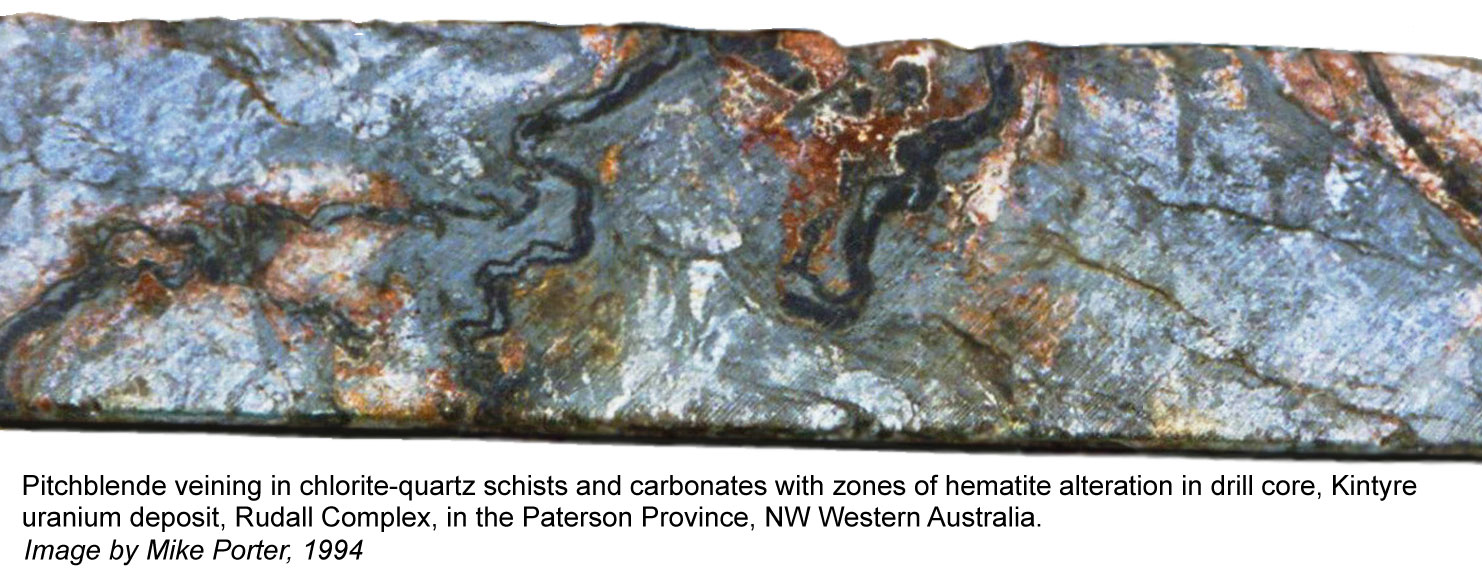|
Kintyre |
|
|
Western Australia, WA, Australia |
| Main commodities:
U
|
|
 |
|
 |
 |
Super Porphyry Cu and Au


|
IOCG Deposits - 70 papers

|
All available as eBOOKS
Remaining HARD COPIES on
sale. No hard copy book more than AUD $44.00 (incl. GST) |
|
 |
The Kintyre uranium deposit is located within the Proterozoic Paterson Province of Western Australia, 60 km south of the Telfer gold mine and 260 km NNE of the town of Newman. It is an unconformity-associated, vein type orebody (similar to those of the East Aligator River Province, NT, Australia and the Athabasca Basin, Saskatchewan, Canada)
The deposit lies within the Rudall Complex which comprises two suites, i). an older, possibly Archaean, granite gneisses with inliers of quartzo-feldspathic gneisses, schists, iron formations and mafic/ultramafic gneisses, and ii). a younger suite dominated by quartzite, quartz-muscovite schist and lesser BIF, metachert, graphitic schist, marble, chlorite-carbonate schists and metabasalt. The latest deformation in the complex is dated at between 1530 and 1330 Ma.
The Rudall Complex is overlain above a marked angular unconformity by the Coolbro Sandstone of the Yeeneena Group which comprises quartz sandstone with rare thin carbonaceous mudstone and shale interbeds and conglomerate bands. This Group was deformed at around 1130 Ma.
The Kintyre ore zone occurs within chlorite-quartz schists, chlorite-carbonate-quartz schists and variably chloritic and garnetiferous quartzite (metachert) associated with carbonates in the axial zone of a recumbent, gently ENE plunging antiform. The dominant style of mineralisation comprises F1 cleavage controlled pitchblende veining which forms discrete ore zones within the upper limb of the F1 antiform. Chlorite, dolomite, ankerite and calcite are dominant vein gangue, with either or both carbonate and chlorite predominating. Weaker disseminated pitchblende is also recognised. Accessory and trace bismuth, bismuthinite, chalcopyrite, bornite, galena and gold are associated with the pitchblende.
The main orebody has a strike length of 400 m, is 100 to 200 m wide and up to 70 m thick. This volume is made up of narrow pitchblende veins in sets within 1 to 10 m thickness ore zones, separated by barren host schists. These ore zones in aggregate make up the ore lense that dips north at 20 to 50°. Alteration is mainly chloritisation and weak localised hematisation.
The deposit has a total resource of - 36 000 t of U3O8 with grades averaging from 1.5 to 4.0 kg/t U3O8, comprising:
Probable reserve - 22 000 t,
Indicated resource - 11 000 t,
Inferred resource - 3 000 t,
These figures were based on a 0.5 kg/t U3O8 cut-off and include the blind Whale and Pioneer deposits within 1500 m of the main Kintyre ore lens.
Resources as at 31 December 2021 (Cameco Reserves and Resources Report, 2022) were:
Indicated Mineral Resource - 3.8977 Mt @ 0.62% U3O8, containing 24 267 tonnes of U3O8;
Inferred Mineral Resource - 0.5171 Mt @ 0.53% U3O8, containing 2 722 tonnes of U3O8.

For detail consult the reference(s) listed below.
The most recent source geological information used to prepare this decription was dated: 1994.
This description is a summary from published sources, the chief of which are listed below.
© Copyright Porter GeoConsultancy Pty Ltd. Unauthorised copying, reproduction, storage or dissemination prohibited.
|
|
|
Selected References:
|
Jackson D G, Andrew R L 1990 - Kintyre Uranium deposit: in Hughes F E (Ed.), 1990 Geology of the Mineral Deposits of Australia & Papua New Guinea The AusIMM, Melbourne Mono 14, v1 pp 653-658
|
Maidment, D.W., Huston, D.L. and Beardsmore, T., 2017 - Paterson Orogen geology and metallogeny: in Phillips, G.N., (Ed.), 2017 Australian Ore Deposits, The Australasian Institute of Mining and Metallurgy, Mono 32, pp. 411-416.
|
Root, J.C. and Robertson, W.J., 1994 - Geophysical signature of the Kintyre uranium deposit, Western Australia: in Geophysical Signatures of Western Australian Mineral Deposits, Geology and Geophysics Department (Key Centre) and UWA Extension, The University of Western Australia, ASEG Extended Abstracts, 1994, Publication No. 26, 1994, pp. 371-381. doi.org/10.1071/ASEGSpec07_27.
|
|
Porter GeoConsultancy Pty Ltd (PorterGeo) provides access to this database at no charge. It is largely based on scientific papers and reports in the public domain, and was current when the sources consulted were published. While PorterGeo endeavour to ensure the information was accurate at the time of compilation and subsequent updating, PorterGeo, its employees and servants: i). do not warrant, or make any representation regarding the use, or results of the use of the information contained herein as to its correctness, accuracy, currency, or otherwise; and ii). expressly disclaim all liability or responsibility to any person using the information or conclusions contained herein.
|
Top | Search Again | PGC Home | Terms & Conditions
|
|